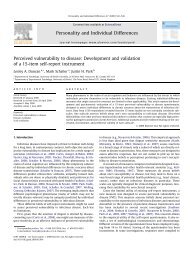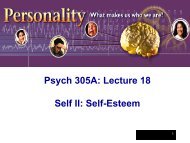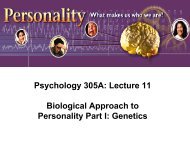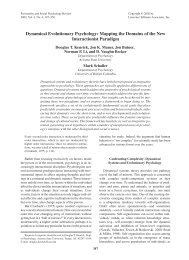Culture and the Self: Implications for Cognition, Emotion, and ... - iacmr
Culture and the Self: Implications for Cognition, Emotion, and ... - iacmr
Culture and the Self: Implications for Cognition, Emotion, and ... - iacmr
Create successful ePaper yourself
Turn your PDF publications into a flip-book with our unique Google optimized e-Paper software.
246 HAZEL ROSE MARKUS AND SHINOBU KITAYAMA<br />
contexts are <strong>the</strong> defining features of <strong>the</strong> self. In <strong>the</strong> words of<br />
Lebra (1976), <strong>the</strong> individual is in some respects "a fraction" <strong>and</strong><br />
becomes whole when fitting into or occupying one's proper<br />
place in a social unit. The sense of individuality that accompanies<br />
an interdependent self includes an attentiveness <strong>and</strong> responsiveness<br />
to o<strong>the</strong>rs that one ei<strong>the</strong>r explicitly or implicitly<br />
assumes will be reciprocated by <strong>the</strong>se o<strong>the</strong>rs, as well as <strong>the</strong><br />
willful management of one's o<strong>the</strong>r-focused feelings <strong>and</strong> desires<br />
so as to maintain <strong>and</strong> fur<strong>the</strong>r <strong>the</strong> reciprocal interpersonal relationship.<br />
One is conscious of where one belongs with respect to<br />
o<strong>the</strong>rs <strong>and</strong> assumes a receptive stance toward <strong>the</strong>se o<strong>the</strong>rs, continually<br />
adjusting <strong>and</strong> accommodating to <strong>the</strong>se o<strong>the</strong>rs in many<br />
aspects of behavior (Azuma, 1984; Weisz et al., 1984). Such acts<br />
of fitting in <strong>and</strong> accommodating are often intrinsically rewarding,<br />
because <strong>the</strong>y give rise to pleasant, o<strong>the</strong>r-focused emotions<br />
(e.g., feeling of connection) while diminishing unpleasant ones<br />
(e.g., shame) <strong>and</strong>, fur<strong>the</strong>rmore, because <strong>the</strong> self-restraint required<br />
in doing so <strong>for</strong>ms an important basis of self-esteem.<br />
Typically, <strong>the</strong>n, it is o<strong>the</strong>rs ra<strong>the</strong>r than <strong>the</strong> self that serve as <strong>the</strong><br />
referent <strong>for</strong> organizing one's experiences.<br />
With an independent construal of <strong>the</strong> self, o<strong>the</strong>rs are less<br />
centrally implicated in one's current self-definition or identity.<br />
Certainly, o<strong>the</strong>rs are important <strong>for</strong> social comparison, <strong>for</strong> reflected<br />
appraisal, <strong>and</strong> in <strong>the</strong>ir role as <strong>the</strong> targets of one's actions,<br />
yet at any given moment, <strong>the</strong> self is assumed to be a complete,<br />
whole, autonomous entity, without <strong>the</strong> o<strong>the</strong>rs. The defining features<br />
of an independent self are attributes, abilities, traits, desires,<br />
<strong>and</strong> motives that may have been social products but that<br />
have become <strong>the</strong> "property" of <strong>the</strong> self-contained individual<br />
(see Sampson, 1989) <strong>and</strong> that are assumed to be <strong>the</strong> source of<br />
<strong>the</strong> individual's behavior. The sense of individuality that accompanies<br />
this construal of <strong>the</strong> self includes a sense of oneself as an<br />
agent, as a producer of one's actions. One is conscious of being<br />
in control over <strong>the</strong> surrounding situation, <strong>and</strong> of <strong>the</strong> need to<br />
express one's own thoughts, feelings, <strong>and</strong> actions to o<strong>the</strong>rs, <strong>and</strong><br />
is relatively less conscious of <strong>the</strong> need to receive <strong>the</strong> thoughts,<br />
feelings, <strong>and</strong> actions of o<strong>the</strong>rs. Such acts of st<strong>and</strong>ing out are<br />
often intrinsically rewarding because <strong>the</strong>y elicit pleasant, egofocused<br />
emotions (e.g., pride) <strong>and</strong> also reduce unpleasant ones<br />
(e.g., frustration). Fur<strong>the</strong>rmore, <strong>the</strong> acts of st<strong>and</strong>ing out, <strong>the</strong>mselves,<br />
<strong>for</strong>m an important basis of self-esteem.<br />
The Role of <strong>the</strong> <strong>Self</strong><br />
The relative importance that is accorded to o<strong>the</strong>rs in <strong>the</strong>se<br />
two construals has a wide range of psychological implications.<br />
In this article, we have outlined some of <strong>the</strong> cognitive, emotional,<br />
<strong>and</strong> motivational consequences of holding a view of <strong>the</strong><br />
self that includes o<strong>the</strong>rs <strong>and</strong> that requires o<strong>the</strong>rs to define <strong>the</strong><br />
self. Although a rapidly exp<strong>and</strong>ing volume of studies suggest<br />
that some aspects of cognitive functioning are relatively hardwired,<br />
many features of <strong>the</strong> way people perceive, categorize, or<br />
assign causality are probably not basic processes that derive in<br />
any straight<strong>for</strong>ward way from <strong>the</strong> functioning of <strong>the</strong> human<br />
machinery or "hardware." Ra<strong>the</strong>r, <strong>the</strong>se processes are to a large<br />
extent personal, reflecting <strong>the</strong> nature of <strong>the</strong> self that anchors<br />
<strong>the</strong>m. Thus, <strong>the</strong>y reflect all of those factors, including cultural<br />
aspects, that jointly determine <strong>the</strong> self. If one perceives oneself<br />
as embedded within a larger context of which one is an interdependent<br />
part, it is likely that o<strong>the</strong>r objects or events will be<br />
perceived in a similar way. For example, a given event involving<br />
a particular actor will be perceived as arising from <strong>the</strong> situational<br />
context of which this actor is an interdependent part,<br />
ra<strong>the</strong>r than as stemming solely from <strong>the</strong> attributes of <strong>the</strong> actor.<br />
Or, in answering any question, one's first tendency may be to<br />
consider <strong>the</strong> particular social situation that is defined by <strong>the</strong><br />
current interaction (e.g., teacher-student, worker-co-worker,<br />
<strong>and</strong> younger-elder) <strong>and</strong> <strong>the</strong>n to gauge <strong>the</strong> range of responses<br />
that are most appropriate to this situation. These construals of<br />
self are probably abstracted through early patterns of direct<br />
interactions with parents <strong>and</strong> peers. The way people initially,<br />
<strong>and</strong> thus <strong>the</strong>reafter, most naturally or ef<strong>for</strong>tlessly perceive <strong>and</strong><br />
underst<strong>and</strong> <strong>the</strong> world is rooted in <strong>the</strong>ir self-perceptions <strong>and</strong><br />
self-underst<strong>and</strong>ings, underst<strong>and</strong>ings that are <strong>the</strong>mselves constrained<br />
by <strong>the</strong> patterns of social interactions characteristic of<br />
<strong>the</strong> given culture.<br />
Consequences <strong>for</strong> <strong>Self</strong>-Processes<br />
Our discussion of <strong>the</strong> cognitive, emotional, or motivational<br />
consequences has by no means exhausted <strong>the</strong> range of potential<br />
consequences of holding an independent or interdependent<br />
construal of <strong>the</strong> self. Consider first <strong>the</strong> set of processes connected<br />
by a hyphen to <strong>the</strong> self. It is reasonable to assume that all<br />
of <strong>the</strong>se phenomena (e.g., self-affirmation [Steele, 1988], selfverification<br />
[Swann, 1983], self-consciousness [Fenigstein,<br />
Scheier, & Buss, 1975], self-control [Carver & Scheier, 1981],<br />
self-actualization [Maslow, 1954], or self-h<strong>and</strong>icapping [Jones<br />
& Berglas, 1978]) could assume a somewhat different <strong>for</strong>m depending<br />
on how interdependent <strong>the</strong> self is with o<strong>the</strong>rs.<br />
<strong>Self</strong>-esteem <strong>for</strong> those with an independent construal of <strong>the</strong><br />
self depends on one's abilities, attributes, <strong>and</strong> achievements.<br />
The most widely used measure of self-esteem, <strong>the</strong> Rosenberg<br />
<strong>Self</strong>-Esteem Scale, requires <strong>the</strong> endorsement of items like "I am<br />
a person of worth" or "I am proud of my abilities." <strong>Self</strong>-esteem<br />
associated with an interdependent self could include endorsement<br />
of similar items, although what it means to be, <strong>for</strong> example,<br />
a person of worth could well have a different meaning. Or<br />
high self-esteem may be more strongly associated with an endorsement<br />
of items that gauge one's ability to read <strong>the</strong> situation<br />
<strong>and</strong> to respond as required. If this is <strong>the</strong> case, a threat or a<br />
challenge to <strong>the</strong> self may not come in <strong>the</strong> <strong>for</strong>m of feedback that<br />
one is unlike a cherished conception of <strong>the</strong> inner or dispositional<br />
self (dumb instead of smart; submissive ra<strong>the</strong>r than dominant)<br />
but instead in terms of a threat of a disruption of, or a<br />
disconnection from, <strong>the</strong> relation or set of relations with which<br />
one <strong>for</strong>ms an interdependent whole.<br />
The focus on <strong>the</strong> distinction between independent versus<br />
interdependent selves has <strong>the</strong> potential to provide a means of<br />
integrating research on a large number of separate personality<br />
constructs. One of <strong>the</strong> significant distinctions that appears repeatedly<br />
throughout Western psychology reflects a variation<br />
among individuals in how tuned in, sensitive to, oriented toward,<br />
focused on, or concerned <strong>the</strong>y are with o<strong>the</strong>rs. The introversion-extraversion<br />
dimension reflects this difference, as does<br />
<strong>the</strong> inner-directed-outer-directed distinction (Reisman, Denney,<br />
& Glazer, 1950). O<strong>the</strong>r related distinctions include high<br />
versus low self-monitoring (Snyder, 1979), personal identity







